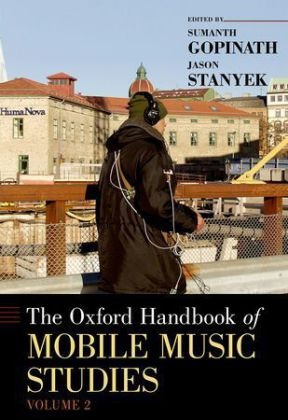Read more
Zusatztext A very welcome and totally immersive experience. Informationen zum Autor Sumanth Gopinath is the author of The Ringtone Dialectic: Economy and Cultural Form (2013). His writings on Steve Reich, musical minimalism, Marxism, academic politics, ringtones, Bob Dylan, and Benjamin Britten have appeared in scholarly journals including Music Theory Spectrum, Journal of the Society for American Music, and First Monday, and in the edited collections Sound Commitments, Highway 61 Revisited, and Music and Narrative since 1900.Jason Stanyek is University Lecturer in Ethnomusicology at the University of Oxford, where he is also Fellow and Tutor in Music at St John's College. His writings on Brazilian music, improvisation, music technology, and jazz have appeared in a range of academic journals and edited collections. Forthcoming books include a monograph on music and dance in the Brazilian diaspora and a volume (co-edited with Frederick Moehn) titled Brazil's Northern Wave: Fifty Years of Bossa Nova in the United States.Jason Stanyek is University Lecturer in Ethnomusicology at the University of Oxford, where he is also Fellow and Tutor in Music at St John's College. His writings on Brazilian music, improvisation, music technology, and jazz have appeared in a range of academic journals and edited collections. Forthcoming books include a monograph on music and dance in the Brazilian diaspora and a volume (co-edited with Frederick Moehn) titled Brazil's Northern Wave: Fifty Years of Bossa Nova in the United States. Klappentext This handbook examines how electrical technologies and their corresponding economies of scale have rendered music and sound increasingly mobile-portable, fungible, and ubiquitous. Highly interdisciplinary, the two volumes of the Oxford Handbook of Mobile Music Studies consider the devices, markets, and theories of mobile music, and its aesthetics and forms of performance. Zusammenfassung This handbook examines how electrical technologies and their corresponding economies of scale have rendered music and sound increasingly mobile -- portable, fungible, and ubiquitous. Highly interdisciplinary, the two volumes of the Oxford Handbook of Mobile Music Studies consider the devices, markets, and theories of mobile music, and its aesthetics and forms of performance. Inhaltsverzeichnis Contents: 1. The Mobilization of Performance: An Introduction to the Aesthetics of Mobile Music Sumanth Gopinath and Jason Stanyek Part I: Frequency-Range Aesthetics 2. Treble Culture Wayne Marshall 3. Of Sirens Old and New Alexander Rehding Part II: Sounding Transport 4. "Cars With the Boom": Music, Automobility, and Hip-hop "Sub" Cultures Justin Williams 5. Ding, Ding!: The Commodity Aesthetic of Ice Cream Truck Music Daniel T. Neely 6. There must be some relatIon beTween mushrOoms and trains: Alvin Curran's Boletus Edulis-Musica Pendolare Benjamin Piekut Part III: Walking and Bodily Choreography 7. Polyphonies of Footsteps Frauke Behrendt 8. Soundwalking: Creating Moving Environmental Sound Narratives Andra McCartney 9. Gestural Choreographies: Embodied Disciplines and Digital Media Harmony Bench Part IV: Dance and Dance Musics 10. (In)Visible Mediators: Urban Mobility, Interface Design, and the Disappearing Computer in Berlin-Based Laptop Performances Mark J. Butler 11. Turning the Tables: Digital Technologies and the Remixing of DJ Culture Christine Zanfagna and Levitt Brandin, Kate 12. Dancing Silhouettes: The Mobile Freedom of iPod Commercials Justin D. Burton Part V: Popular Music Production 13. Music, Mobility, and Distributed Recording Production in Turkish Political Music Eliot Bates 14. Rhythms of Relation: Black Popular Music and Mobile Technologies Alexander Weheliye Part VI: Gaming Aesthetics 15. A History of Handheld and Mobile Vi...

